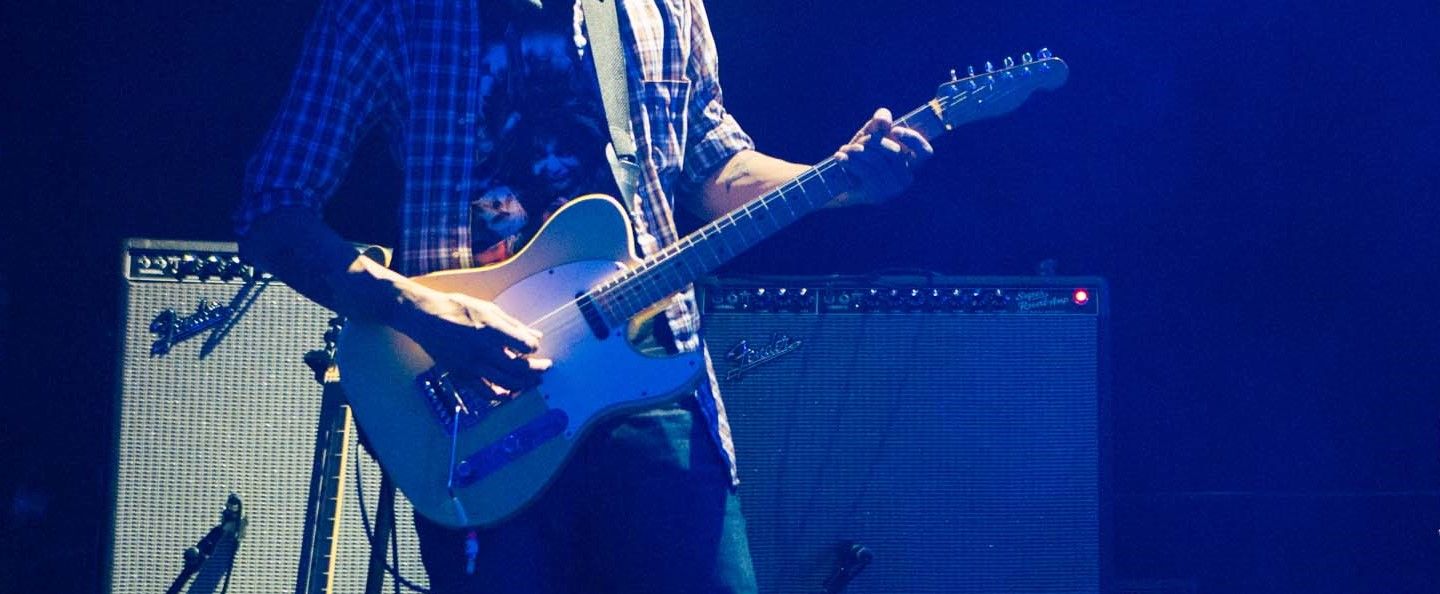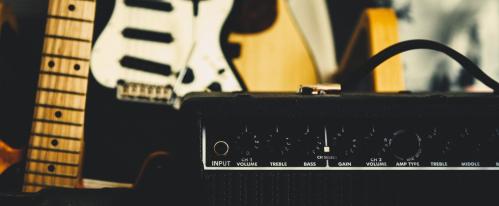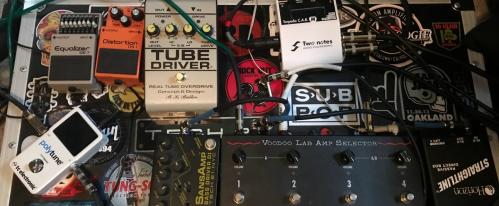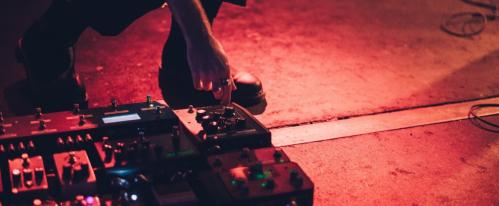We take a closer look at the best guitars, amps, and pedals to help you sound like Slint and recreate the Spiderland sound
“In 10 years it will be a landmark and you’ll have to scramble to buy a copy then”.
These words from Steve Albini’s 10-star review of Spiderland have certainly proved to be prophetic. Even now, over 30 years since the record was released by Touch and Go, people are still obsessed with how Slint wrote and recorded their sophomore album.
Despite disbanding prior to its release in March 1991, Slint helped to usher in a new contingent of bands who would use the sound of Spiderland as the blueprint for their art - effectively creating what is now known as ‘post-rock’ whilst simultaneously pulling from influences in hardcore, math rock, and indie.
Keep reading to check out our full Slint gear guide and find out how you can change up your rig to get a little bit closer to the Spiderland guitar tone..
Slint Guitar Tone: The Spiderland Sound
Much has been written about the sound of Spiderland - a record once steeped in mystery but that has since been dissected and analysed by music fans from across the globe.
The concept of the band, at least according to drummer Britt Walford, was to sound like nature - resilient, in the way that a fresh plant might be.
Allegedly named after the ‘spidery’ sound of the recordings, the precise and intricate guitar work that is laid out across the album’s 6 tracks is unique and distinctive. Making use of some ultra-complex rhythms, riffs, and structures, the brooding chords ooze with tension amidst the sinister sonic landscape that is equally as discordant as it is beautifully orchestrated.
Lead guitarist David Pajo has spoken openly about his fondness for ‘anti-guitar’ moves, pointing to his one-note solos, wailing feedback, and screeching harmonics as evidence of this approach to his instrument.
But how can you achieve the elusive Slint guitar tone? We’ve picked out some guitars, amplifiers, and pedal options that will help you to add some Slint-inspired sounds to your music.

What Guitars Did Slint Use?
Despite the range of abnormal guitar sounds that Slint displays on Spiderland, the instruments used by the band are fairly traditional.
Relying mainly on Fender guitars, Brian McMahan and David Pajo are frequent players of Telecasters and Stratocasters respectively - often with upgraded active pickups that enhance the clarity needed for the disparate clean and distorted tones that the band use.
Check out a full range of Teles and Strats here:
Fender Player Plus Series
The Fender Player Plus range offers up a selection of all-new Strats and Teles that feature some awesome premium upgrades.
Each model utilises noiseless pickups that are perfectly suited for switching between clean tones and hi-gain sounds, all whilst avoiding the hum that plagues traditional single-coil pickups. The volume knob on each model also features a built-in treble bleed circuit, and with expanded switching options across each guitar in the collection you’re granted an array of new sounds straight from your axe.
These guitars also debut some bits of premium hardware, plus with the addition of some advanced neck shaping and rolled fingerboard edges the Player Plus collection allows you to really push your instrument and shred without fear of choking out on a bend or throwing your guitar out of tune.
For Slint-inspired tones you can’t go wrong with the standard Strat and Tele models, but you can also check out the HSS Strat if you want to add a humbucker to your palette of tones.

Slint Guitar Tunings
Many of Slint’s contemporaries experimented heavily with alternate tunings. Looking at other seminal 90’s alternative records such as Slanted and Enchanted or Loveless, there are huge amounts of variance in how guitars were set up - from the ‘Malkmus Tuning’ of CGDGBE to the more experimental F#F#F#F#C#F# used on the epic MBV album closer Soon.
It may surprise you to learn then that Slint kept things pretty simple with their tunings. Spiderland is written mainly between Standard tuning and Drop D - most of the discordance and tension present is generated by the composition itself.
The band employs the use of some atypical scales and ‘wrong’ notes in order to get this effect - so don’t be afraid to try bending the rules in your own songs.
Slint Guitar Amps
The guitarists of Slint have been pictured using a couple of different amps at various live shows throughout the years, and there aren’t many resources for finding out exactly how they recorded the parts for Spiderland.
Most of the sounds can be achieved by using a solid state amp with lots of headroom for pedals - the use of solid state amplifiers means that you can use a cleaner tone at higher volumes, something that Slint makes extensive use of. Amplifiers of this type also serve as a great base for adding pedals and shaping your tone from there.
We’ve done a little bit of digging and picked out some options that will help to get you closer to the band’s legendary sound..
Fender Amps
Slint has reunited on a number of occasions over the years, playing Spiderland in full and also touring with some earlier material from Tweez. During these shows they were often pictured using Fender amplifiers (as shown in the image at the top of this blog).
You can shop a full range of Fender amplifiers at PMT here:
Our favourite pick from Fender is this Tonemaster Deluxe Reverb. With a host of modern features alongside the typically immaculate Fender clean tone, it’s a wonderful option for both recording and playing live.

It weighs about half as much as an original Deluxe Reverb but still features the same channels, inputs, control panel, and effects.
The five attenuated settings mean that you can still practice at home or in other low-volume environments, and thanks to the 100-watt power rating of the digital power amp it’s able to achieve the kind of headroom and dynamic range that you’d expect from a far more expensive amplifier.
BOSS Katana

The BOSS Katana range of amps are also a great option for those chasing the elusive Spiderland guitar tone.
Featuring a range of distortion, delay, modulation, and reverb across each model, they’re especially useful for those who don’t want to use pedals. BOSS are the industry-leading brand when it comes to stompbox effects, and these built-in options are just as powerful and flexible as you’d expect - perfect for those who prefer to not use a pedalboard.
The distortion and reverb effects in particular are useful for Slint-esque sounds, allowing you to add dirt and space to your tone.
The amps are available in a range of sizes, as well as in combo or head/cabinet set-ups - and with attenuation available on the more powerful models you can use the same rig for practice and at gigs.
The clean tone across this collection is superb - something that is particularly important when aiming for Slint guitar sounds - and it comes with some ultra-modern conveniences such as BOSS Tone Studio, too.
Check out the full range of Katana amps here:
Slint Guitar Pedals
For those who want to sculpt their guitar sound using stompboxes we’ve picked out a range of distortion and fuzz units that are certain to nail the Spiderland sound.
Slint often used easy-to-find and inexpensive pedals in the years before they broke up, although some of these FX have since gone on to become rare and highly-sought due to the influential sound of various artists who used them.
By analysing some different Slint pedalboards from over the years we’ve selected the following units that will help you to achieve a similar guitar sound to the Louisville natives.
MXR M104 Distortion+

Originally designed in the 1970s, the MXR M104 Distortion+ pedal uses a single op-amp and a pair of germanium diodes to clip the guitar signal and offer a crunchy metal tone.
Rumoured to have been used by Slint both in the studio and at live shows, it has also found favour with Bob Mould of Hüsker Dü and Thom Yorke of Radiohead.
With a super-simple design that only features two knobs - a level control and distortion control - the pedal achieves its unique sound by boosting treble-frequencies as the distortion knob is turned up. This eliminates the need for a tone control and offers an extra top-boost as the distortion increases, making it ideally suited for the Spiderland tone.
BOSS HM-2W Heavy Metal Waza Craft

The original version of this pedal has been used by David Pajo at Slint live shows - and the Waza Craft upgrade means you get access to all of his tones and more.
Set this pedal to the standard mode and you get the original HM-2 tone but with lower noise and maximized level. Activating the custom mode, meanwhile, provides a more aggressive sound variation with special Waza Craft tuning.
The custom mode grants you a drive stage with more gain for increased attack and sharpness, as well as tweaked low and high-mid characteristics for increased definition.
The original HM-2 is responsible for the death metal ‘chainsaw sound’ and was also used extensively by Bilinda Butcher of My Bloody Valentine, proving its versatility for both ultra-heavy distortion and boosted fuzz tones.
Pajo seems to use his original HM-2 with the distortion and ‘H’-colour at around 2 o’clock, setting the ‘L’-colour to almost 0 and maxing out the level for a boost from his clean tone. Try playing around with the settings in each of the different modes to find a top-boosted crunch for rhythm playing, then add some extra distortion when you want to make your harmonics sing.
BOSS DS-1

A truly classic pedal, this stompbox has been used by everyone from Kurt Cobain to Steve Vai.
The rugged housing and distinctive orange design are built to last, whilst the rich sound is engineered to enhance the intricacies of your pickups and playing style.
A pioneering two-stage circuit in this pedal provides both transistor and op-amp gain stages, and the innovative tone circuit allows for complete flexibility for searing leads and thick, crunchy rhythm playing.
Take a look at this video for some further details on this iconic unit:
Electro-Harmonix Big Muff Pi

The Spiderland pedal sound can also be achieved with one of the many Big Muff Pi variants from Electro-Harmonix.
The original Big Muff is an ever-reliable choice, and it’s also available in Little and Nano variations if you’re short on pedalboard real estate. For extra tone-sculpting capabilities check out the Tone-Wicker pedal, or see the Triangle Muff for a more vintage-flavoured approach to your fuzz.
The Deluxe Sovtek version is a reproduction of the famous green unit that boasts a fatter low-end sound, whilst the Ram’s Head Muff was favoured by David Gilmour for some iconic Pink Floyd tones.
There is also another Sovtek variant called the ‘Green Russian Big Muff’, whilst the other Deluxe version of the standard Muff is a great option too.
For the most hi-gain of Slint’s tones you could opt for the Metal Muff. This unit offers a huge array of sounds that are reminiscent of the hardcore bands which no doubt will have influenced Slint when creating Spiderland, and it also comes in a Nano variant so you can still achieve that American Metal sound even if you’re lacking space on your board.
Slint liked to use pedals that were aimed at metal players - such as the HM-2 and the now-discontinued DOD American Metal - so the Metal Muff is ideally-suited for replicating those sort of extreme tones you hear on ‘Breadcrumb Trail’ and ‘Good Morning, Captain’.
Want to know more about the Slint Spiderland guitar gear? Got a question about a certain guitar tone from Spiderland? Call us on 0151 448 2089 or check out your local store to speak to one of our Experts about your needs.




